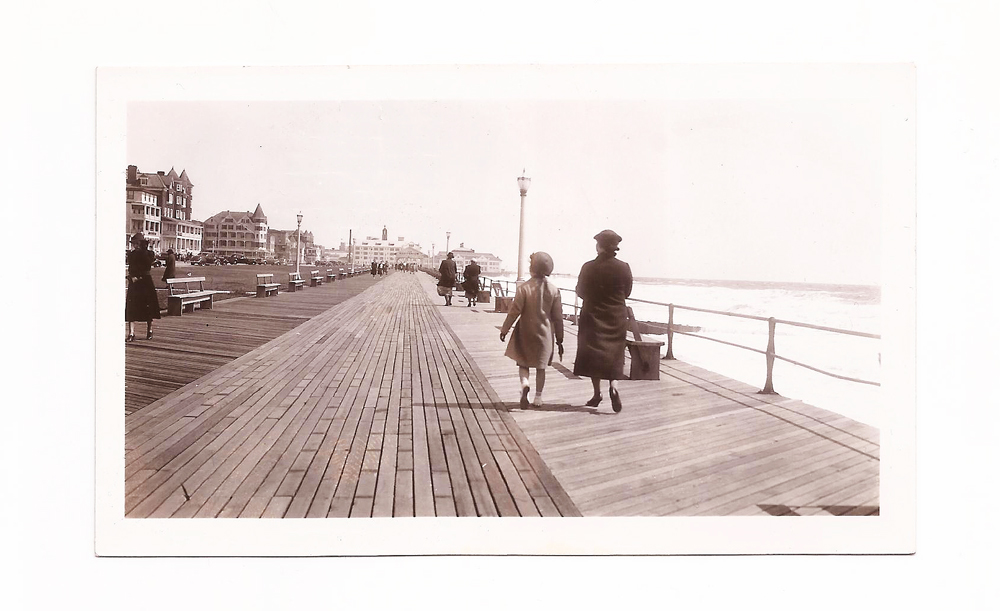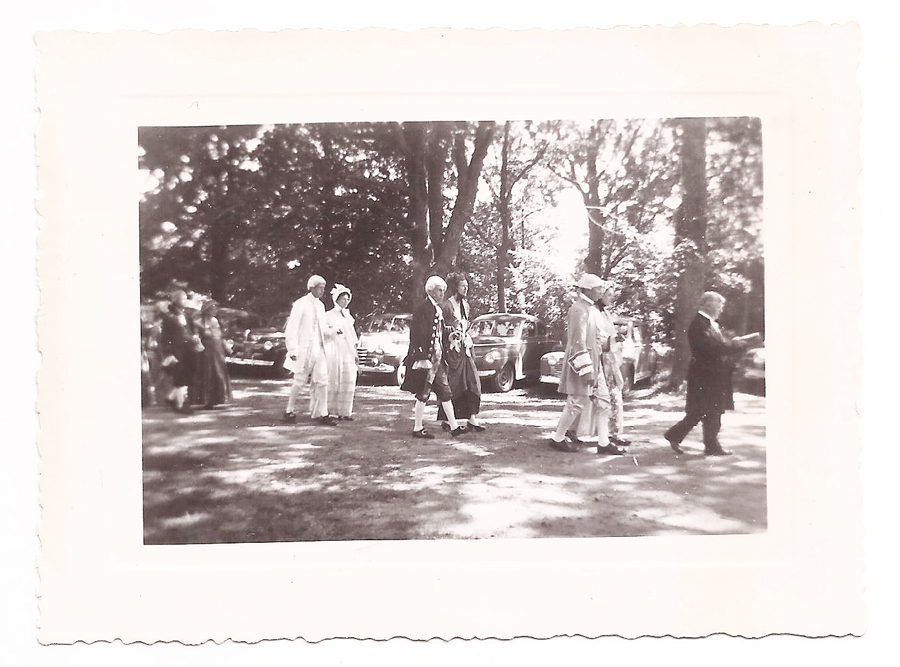Someone had turned in six albums to the store, thick as dictionaries, each full to bursting with slivered photos askew in their pockets. There were eight or nine of every setup; Chester the photographer took no chances. Each was numbered according to some system that began again from zero at points that seemed arbitrary, and sometimes I look at the numbers (typed in red first, stamped in black later) and wonder what the catalyst was. It wasn’t reset at the start of a new album or office job or calendar year; maybe he just rolled over to zero whenever he left something behind for something else.
I don’t know how they got to the store where I found them, two or three years back. Someone in New Jersey had given them away. Chester might have had a dozen of these albums, filled with photos painstakingly numbered according to a system he swore by and that sounded like arcane summonings to anyone else. Maybe Chester’s grandchildren were already knee-deep in photos he took of them, and had given away only the ones full of the boring work friends he couldn’t even recall by the time they asked him, not without looking at the back of the photos. Maybe Chester didn’t have any grandchildren, and a landlord was just cleaning house after the fact.
They were for sale by the photo, by the page, by the book. I wished I had the money for the collection. I was too much of an asshole to take a full page just because I liked a single shot. But I couldn’t leave them be, either; vulturism had already set in.
Whoever got to them after me had a dozen holes in their collection, teeth pulled from the middle of a lineup. Maybe they wonder why I took the ones I took, flipping through like a detective on a cold case, wondering what they were missing.
A man and a woman in close-up, their temples pressed together. The picture’s been cut down from the original size, nearly straight but not quite – her chin is sliced off, a casualty of a razor and an unsteady hand, leaving only the line of her bob along the bottom of the picture, the arch of his Harold Lloyd glasses at the top. He looks like he can’t believe his luck; she looks like she can’t believe his luck, either.
“No. 177: Edna Kessler and Wm Foell, taken by Chester 7/1/28 on the roof of 288 West St., Union City, N.J.”
The boardwalk is split into thirds lengthwise, each of which has boards laid at a different angle. They recede from the bottom edge of the photo, framed with hotels on the left and the sea on the right, the subjects of the photo walking smack in the mark of the vertical right third. Chester has the eye of a Renaissance painter.
“D79: Marion and Chubby walking on the boardwalk between Avon by the Sea and Asbury Park, N.J., taken by Chester on Monday morning May 30th 1938
Age of Marion: – 9 Years 6 Months 8 Days”
Postcard, found in a curio shop this year, in a drawer reserved for those that had been written on.
Front: A photo of a crocodile crawling slowly over a carpet of crushed reeds toward home, a tableau ringed in sophisticated white.
Caption: MEET IT IS, I SET IT DOWN, THAT ONE MAY SMILE AND SMILE AND BE A VILLAIN.
Back: “Dear Robert – Does the math on the other side apply to me? I used to smile occasionally, didn’t I? Who do you argue with now I am gone? My pen won’t write straight for I’m having quite a fine time down here in Saratoga.
Marion”
My grandfather, in the last decade or so, has turned to genealogy as a hobby. There are binders and binders of family history thick as dictionaries, of which I’ve seen just enough glimpses to be interested, but for which I showed so little aptitude that I was never in the running for apprentice. (Shitty memory. What can you do.)
Once, my family went to the Old Country, and relatives we’d never met who looked exactly like the relatives we’d left behind took us into the woods to look at the ruins of the house that had belonged to the very first known members of our line. They passed around gingerbread cake, and we all ate silently and stared at the rocks that had marked the boundaries of our forefathers, long since claimed back by the moss and the ferns and the mosquitos.
They gave my mother a photo to take back to my grandfather. It was a family portrait a hundred years old, with two people in the right-hand corner they’d never identified, since those two had gone to the States and had no descendants that anybody knew of. They hoped my grandfather might have some idea.
My grandfather had the identical picture. He knew who everyone was, down to the very last.
When I paw through old photos, I hope there’s nothing that leaves holes in a family legacy – please, you always think, if it occurs to you, let not some drunkard nephew have cast these into the back of a sedan and hurled them into the store at dawn just to spite a relative who’d gotten the silverware.
Hopefully it’s a matter of too little space, or too much distance. Families have disconnects. Most people don’t want to play steward to a collection of dead things forever. You can be sad pawing through them, thinking someone’s given them away, maybe, but that’s better than the alternative.
Postcard, found somewhere I wish to hell I could remember.
GARDEN OF EDEN
Lucas, Kansas 67648
Front: A photo of a log cabin made of stone shaped to look like logs, four beams running along the edges to frame it in an open-air pyramid. (The photo’s been taken from a discreet, reserved angle; this close up, you can’t see the sculptures that ring the property, balanced on poles – storks with cement baby heads embedded in them, roiling demons, Adam and Eve.)
Back: “This is S.P. Dinsmoor’s stone log cabin mausoleum. Inside is a room 7 x 10 ft. Two feet above the floor a niche in the wall holds the remains of Dinsmoor in his cement coffin with plate glass covering the entire front. Below is the body of his first wife in a steel vault entirely cemented over on all sides.”
Blank.
It would be a problem if I let it be a problem. Penury helps, and living in New York in an apartment too small to walk through without turning sideways helps, but there are times I walk past a street fair and catch sight of a Rubbermaid container and would be happy to go through five thousand photographs, just in case.
(There’s no Just In Case What. Why would there be?)
A postcard with a sliver of the Empire State Building to indicate where it’s coming from. The rest is filled with a multiple-choice grid of tick-boxes to speed through the pleasantries: how you arrived, what you’re busy with, the sights you’ve seen.
Options under I MISS, all marked:
You
My Liquor
My Honey
The Gang
A photo found in a Rolodex of photos at the corner of a table piled high with vintage cameras.
A collection of majestic post-World War II cars sit in a hulking line at the edge of a woodsy clearing, their headlights paying witness to the parade of people marching past in front of them, two by two, in 18th century court dress. No one’s smiling; whatever’s happening, it’s goddamn serious stuff.
A photo found halfway down a steamer trunk of photos, halfheartedly glued inside a clear plastic sleeve.
Beneath a shack with windows squaring out the wall, a man and a woman sit in a sunken flat of rock, some halfhearted quarry. Coats drape over the rock ledge. They’re having a blast. She’s gripping a Thermos, and giving the camera a mouthful of teeth.
“Fishing party under my ‘studio’
notice broken windows – storm Blew in the glass –
Pap fishing! Martha pouring Tea?!
1918”
Things Chester couldn’t get enough of:
The ocean.
The boardwalk, those three directions of wooden slats guiding the eye out to a single point, the ocean lapping at the negative space.
Wesley Lake, the panorama of the gingerbread buildings and the Ferris wheel nestled inside the curve of the boat rail that frames the bottom edge.
Ships. (“The Morro Castle beached off the steel pier at Asbury Park, N.J. taken by Chester on Sunday afternoon, Oct. 7t, 1934. 107.”)
I wonder who has the rest of the photos. I wonder if I just happen to like these, or if Chester has the eye. Vivian Maier got found that way, with someone stumbling across her and realizing what they had. I suspect I just like glimpses of a life in which I’m not expected to participate – I lose nothing by taking out the photo of his coworkers at the insurance company, lined up on a windy rooftop, their faces lost to fading long ago. I can’t lose anything; I’m way too late.
He refurbished a desk for Marion for Christmas in 1934; she put her teddy bear on top of it for the picture.
In May of 1935, Hope Reformed Church staged “It’s All a Mistake.” The picture of four teenage boys in their dapperest – two wielding bottles and looking distinctly Why I Oughta, one drinking, one holding a paper fan – was taken for “Chubby, the coach of the play.” (It was number 138, sketched in red pencil; maybe Chester had gotten loose in his later years and started to work on the fly.)
Whatever I used to be able to remember about the rest of his work is empty space now. Shitty memory, me and Chester both; if you don’t write it down, you forget.
A couple embracing on a settee in a living room awash in floral wallpaper. It’s lit like a horror movie by accident, which undercuts the heavy beauty of their posture: moments from kissing, eyes already closing, their bodies vanishing into a single axis. The camera’s intruding.
“Douglas Patterson, grandson of my Aunt Maggie, and his wife Helen Patterson, taken by Chester on Monday night Feb. 13th, 1939 in our living room at XXX Union City, N.J. on the occasion of the 71st Birthday Anniversary of my Mother, whose birthday is really 2/17. No. 924.”
There are three dozen, six dozen, a hundred places in the city where you’re welcome to dig through a thousand photos piled in a Rubbermaid bucket under the burning sun.
It seems a little ghoulish to scavenge the bulk photos of the dead. At best, it reads a little dotty, looking through the given-aways like there’s something in there you forgot but you’re sure you’ll recognize as soon as you see it. Still, you always do.
I took out two photos of Chester’s twenty-photo setup of the Teachers of Hope Reformed Bible School. They were both stamped with a black 125 (in red pencil, an afterthought: 108 and 109).
One’s a standard group shot, with the giggles just beginning to spread. In the other, they’ve given up looking official; in the back row, two women are dancing. In the front row, a young man identified as Jay has pulled a strikingly Scarecrow pose. Maria is being pulled off balance by the weight of his right arm (she’s laughing, but has gotten a grip on her hat with one hand – there’s shenanigans and then there’s the trouble you’re in when your hat falls off).
Jay’s left hand is curved to gently frame the face of David, who’s standing slightly apart from the group, just a step, close only to Jay; from inside the graceful frame of Jay’s hand, he doesn’t quite know where to look.
A girl sits in a chair, her head bent with self-conscious absorption to stare down at the stuffed rabbit she holds on her lap – facing her, but just at the edge of her lap. It’s a polite standoff, a distant family meeting. The white drape behind her and the dark smudge that shadows the bottom right corner combine to give the impression of someone opening a door, somehow, though no one is. She’s barely more than a silhouette against so much light; one curl’s fallen out of place, a little spider of hair poised on her forehead she hasn’t bothered to brush back.
“Silhouette of Marion taken by Chester on Tuesday evening Sept. 17th 1935 between the dining and extension rooms of XXX, Union City, N.J. with the aid of two flood lamps and one reflector.
One to one and a half seconds 4.5 Lens
Age of Marion: – 6 Years 9 Months 26 Days”
No number.
 Genevieve Valentine’s most recent novel is speakeasy fairy tale The Girls at the Kingfisher Club. She’s currently the writer of DC’s CATWOMAN. Her stories have been published in Clarkesworld, Journal of Mythic Arts, New Haven Review, and others, and anthologies Federations, After, Fearsome Magics, and more, and have appeared in Best of the Year anthologies. Her nonfiction has appeared at NPR.org, The AV Club, io9.com, Strange Horizons, and LA Review of Books. Her appetite for bad movies is insatiable, a tragedy she tracks at genevievevalentine.com.
Genevieve Valentine’s most recent novel is speakeasy fairy tale The Girls at the Kingfisher Club. She’s currently the writer of DC’s CATWOMAN. Her stories have been published in Clarkesworld, Journal of Mythic Arts, New Haven Review, and others, and anthologies Federations, After, Fearsome Magics, and more, and have appeared in Best of the Year anthologies. Her nonfiction has appeared at NPR.org, The AV Club, io9.com, Strange Horizons, and LA Review of Books. Her appetite for bad movies is insatiable, a tragedy she tracks at genevievevalentine.com.


